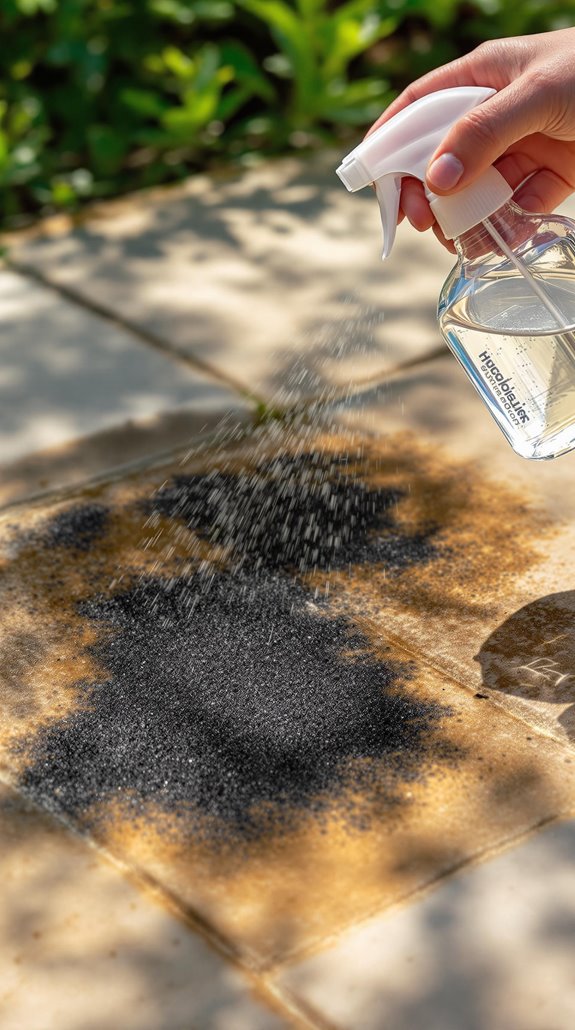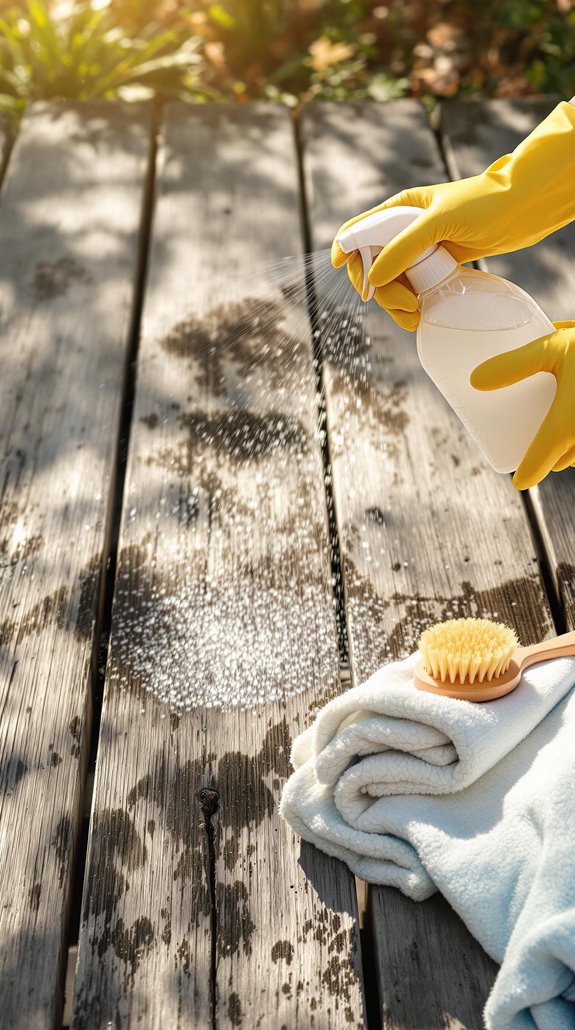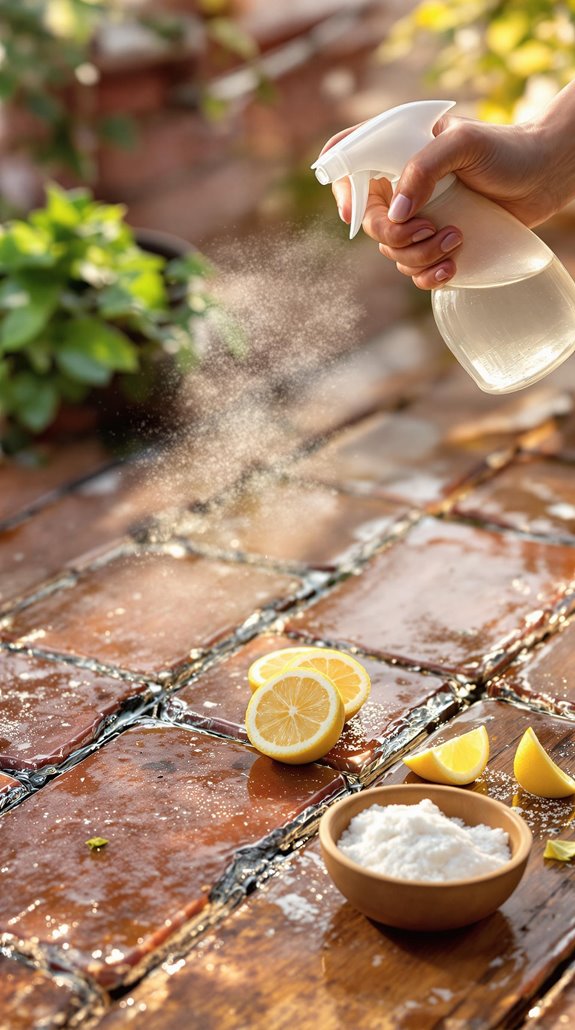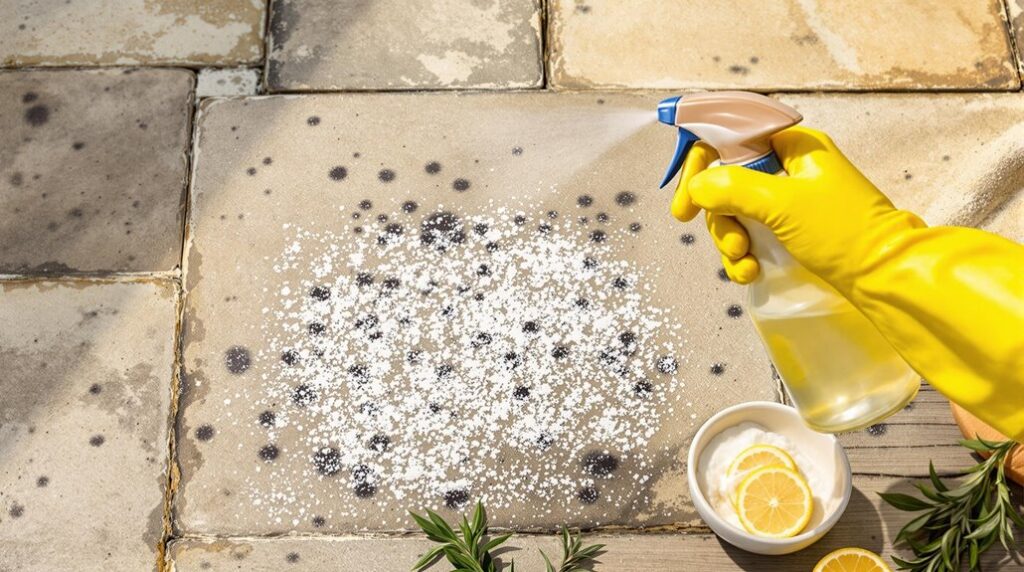I’ve spent years battling those unsightly black spots that plague UK patios, and I’ll share the most effective homemade solutions that actually work. You don’t need expensive commercial cleaners when simple household ingredients can tackle lichen, algae, and stubborn grime just as effectively. I’ve tested various combinations of vinegar, bleach, and baking soda to determine which formulations deliver the best results without damaging your patio surface, and there’s one particular method that consistently outperforms the rest.
Key Takeaways
- Mix equal parts distilled white vinegar and water to create an effective homemade cleaner for black spots.
- Create a paste using three parts baking soda to one part water for gentle spot treatment.
- Combine one part household bleach with five parts warm water for stubborn black spot removal.
- Apply solutions for 20-30 minutes, scrub vigorously, then rinse thoroughly to prevent residue buildup.
- Test homemade cleaners on inconspicuous areas first to avoid damaging natural stone surfaces.
Understanding Black Spots on Your Patio

While those persistent black spots on your patio might look like simple dirt or stains, they’re actually caused by lichen—a complex organism that combines algae and fungus in a symbiotic relationship. I’ve found that lichen embeds deeply into porous surfaces like sandstone, concrete, and limestone, feeding on minerals such as iron within the stone.
These organisms thrive in damp, shaded conditions, particularly on north-facing patios or areas under trees. What makes them so stubborn is their ability to anchor deep roots into your paving material. That’s why pressure washing only removes surface growth—the embedded roots remain intact, causing regrowth within months.
Understanding this biological process is essential because it explains why conventional cleaning methods fail and why you need targeted homemade solutions. The problem becomes worse when water pooling occurs on your patio, as stagnant moisture creates the perfect breeding ground for these organisms to establish and multiply.
Distilled White Vinegar Solutions for Spot Removal
Distilled white vinegar offers one of the most accessible homemade solutions for tackling black spots on your patio. I’ve found the acetic acid effectively breaks down dirt and grime whilst targeting light mould and mildew on non-porous surfaces.
I recommend mixing equal parts distilled white vinegar and water for your standard solution. For enhanced cleaning power, I combine baking soda, vinegar, and washing-up liquid with warm water. Always test on an inconspicuous area first—undiluted vinegar can cause discolouration.
Apply the solution evenly across your patio, allowing 20-25 minutes for penetration. Scrub vigorously with a stiff-bristled brush, then rinse thoroughly. This method works brilliantly on concrete, porcelain, and composite slabs, though avoid natural stone surfaces where vinegar’s acidity can cause damage. Understanding your paving material’s porosity helps determine the most suitable cleaning approach for optimal results.
Bleach-Based Formulations That Work
Bleach-based solutions provide exceptional results when targeting stubborn black spots that resist milder treatments. I’ve found that mixing one part household bleach with five parts warm water creates an effective general cleaner, while tougher stains require a stronger 1:3 ratio with added dish soap as a surfactant.
For maximum efficacy, I pre-wet the patio surface and apply the solution using a spray bottle, allowing it to dwell for 30 minutes before rinsing. Always test on inconspicuous areas first, as bleach can discolor natural stone.
What’s particularly satisfying is the cost savings—standard household bleach outperforms expensive commercial “black spot removers” that contain identical active ingredients. For persistent lichen, I’ll use chlorine granules from pool supplies as an economical alternative. Once the cleaning is complete, using a stiff brush to scrub the grout lines and edges ensures thorough removal of any remaining residue.
Baking Soda Pastes for Stubborn Stains
Baking soda paste offers a gentler yet highly effective alternative for tackling black spots without the harsh chemical exposure of bleach solutions. I’ve found this method particularly successful for stubborn organic stains that resist standard cleaning.
Create your paste using three parts baking soda to one part water, forming a thick consistency. Apply directly onto affected areas with a putty knife, ensuring quarter-inch coverage. Let it dwell for 15-30 minutes – longer for severe stains. Don’t let it dry completely; mist with water if needed.
Scrub vigorously using stiff-bristled brushes in circular motions, working the paste deep into patio pores. For optimal results, test a patch first to determine the ideal scrubbing duration and effort required for your specific patio surface. Rinse thoroughly with clean water, removing all residue to prevent chalky deposits. This alkaline treatment breaks down organic matter effectively while remaining surface-safe.
Essential Safety and Surface Protection Tips

While removing black spots from patios requires aggressive cleaning methods, protecting yourself and your surfaces remains the top priority throughout the entire process. I’ll always wear wellies, waterproofs, rubber gloves, ear defenders, and safety glasses when tackling these stubborn stains. You can’t be too careful with chemical splashes and loud equipment. Additionally, using energy-efficient devices can help minimize potential increases in electricity bills while cleaning.
I’ve learned that electrical safety is non-negotiable – always use RCDs to prevent electrocution when operating pressure washers. Before applying any homemade solution, I’ll test it on an inconspicuous area first. This simple step has saved me from costly damage countless times. After cleaning, I’ll rinse thoroughly to avoid any staining or slippery residue that could create safety hazards.
For natural stone surfaces, I’ll use the lowest pressure setting possible. Soft stones like sandstone can be permanently damaged by aggressive cleaning, so gentle persistence always beats brute force.
Proper Application Techniques for Best Results
Once you’ve completed your surface preparation and safety setup, the application technique becomes the determining factor between mediocre and outstanding results. I’ll start with a patch test on an inconspicuous area to check compatibility, then treat one full slab to assess effectiveness before expanding coverage.
For even distribution, I use a pump sprayer to apply my homemade solution as a fine mist, saturating the surface without creating pooling. I pour concentrated mixtures directly onto stubborn spots, then agitate with a stiff-bristled brush to penetrate deeply.
Timing’s essential—I allow 30 minutes dwell time for homemade solutions, extending slightly for severe stains while preventing premature drying through reapplication. When working with Indian sandstone, I’m particularly careful to use gentler formulations since this porous natural stone requires specially formulated cleaners to avoid damage. Finally, I rinse systematically with a pressure washer, inspect after drying, and retreat unresolved areas.
Targeting Problem Areas and Weather Considerations

After mastering the application process, I focus my attention on the most challenging areas where black spots persist despite standard treatment approaches. I’ve learned that shaded corners and moisture-trapped zones require concentrated vinegar solutions with extended dwell times. These stubborn areas often need multiple applications before showing results. Additionally, implementing effective drainage solutions can help reduce moisture accumulation, making it easier to manage black spot growth.
Weather timing proves vital for successful treatment. I apply homemade solutions during dry spells, ensuring at least 24 hours without rain. Morning applications work best, allowing maximum contact time before evening moisture returns. Cold temperatures below 10°C reduce cleaning effectiveness, so I wait for milder conditions.
For persistent problem spots, I increase vinegar concentration and add gentle scrubbing with baking soda paste. These targeted approaches help fellow homeowners tackle the most resistant black spot formations that standard methods can’t eliminate. Untreated natural stone surfaces prove particularly challenging as they provide the ideal conditions for mould to establish deeper roots.
Long-Term Prevention and Maintenance Strategies
Since black spots return relentlessly without proper preventive measures, I’ve developed a thorough maintenance system that keeps patios clean year-round. I sweep weekly to remove debris and rinse every two months to prevent buildup. During seasonal changes, I inspect for early moss or algae signs and remove fallen leaves immediately.
My quarterly anti-algae treatments use plant-safe formulas, while I apply SoftWash Pro 50 biocide post-cleaning for six-month protection. I’ve replaced sand joints with polymeric sand to inhibit organic growth and trimmed overhanging branches for increased sunlight exposure.
For cost-effective maintenance, I mix 1:1 water/bleach solutions every eight weeks for spot treatments. I also slope surfaces at 1:80 gradient and install channel drains where water pools persistently. Additionally, I seal my patio annually to create a protective barrier that prevents dirt and water penetration into the surface.
Cost-Effective Cleaning Schedule for Year-Round Results
While commercial patio cleaners can drain your budget quickly, I’ve developed a seasonal cleaning schedule that uses simple household ingredients to maintain spotless surfaces year-round.
I start spring with a vinegar solution (1:1 water ratio) during dry spells, targeting accumulated winter debris and existing black spots. Vinegar is not only an effective cleaner but also environmentally friendly, making it a great choice for outdoor cleaning solutions. Summer’s my intensive period—I clean spills immediately and spot-treat with baking soda paste during sunny days for efficient drying. The warm, humid conditions during summer months create perfect environments for algae and mold to flourish, making regular cleaning essential. Autumn requires bi-weekly sweeping and pre-winter vinegar treatments before temperatures drop.
Winter’s about protection—I use sand instead of salt and delay deep cleaning until spring warmth returns. Year-round, I apply weekly vinegar treatments to emerging spots and store homemade solutions in labeled containers for quick access. This systematic approach keeps costs minimal while delivering professional results.
Conclusion
I’ve shown you proven homemade solutions that’ll tackle your patio’s black spots without breaking the bank. You’ve got vinegar for everyday cleaning, baking soda for gentle scrubbing, and bleach for stubborn stains. Remember to test first, apply systematically, and maintain regularly. These cost-effective methods will keep your patio spotless year-round. Start with the gentlest option and work up as needed. Your patio will look professionally cleaned using ingredients you’ve already got at home.
References
- https://www.stonesuperstore.co.uk/advice/outdoor-paving/how-to-remove-black-spots-from-your-patio
- https://www.softwashing.uk/blogs/news/how-to-get-rid-of-stubborn-black-spots-on-your-patio-for-good
- https://www.softwashing.uk/blogs/news/patio-black-spot-remover-how-to-removing-black-spots-on-your-patio-a-comprehensive-guide
- https://www.elitejetting.co.uk/post/removing-black-spot-guide
- https://www.idealhome.co.uk/house-manual/cleaning/how-to-remove-black-spots-from-patio
- https://jointit.com/blog/how-to-remove-black-spots-on-your-patio/
- https://patioblackspotremoval.com/blogs/news/what-causes-black-spots-on-patios
- https://groups.google.com/g/uk.d-i-y/c/_4O5s8Ia7qo
- https://www.tilemerchant.ie/blog/how-to-remove-black-spots-from-patio/
- https://gkproductsuk.com/blogs/news/removing-black-spots-from-patios

